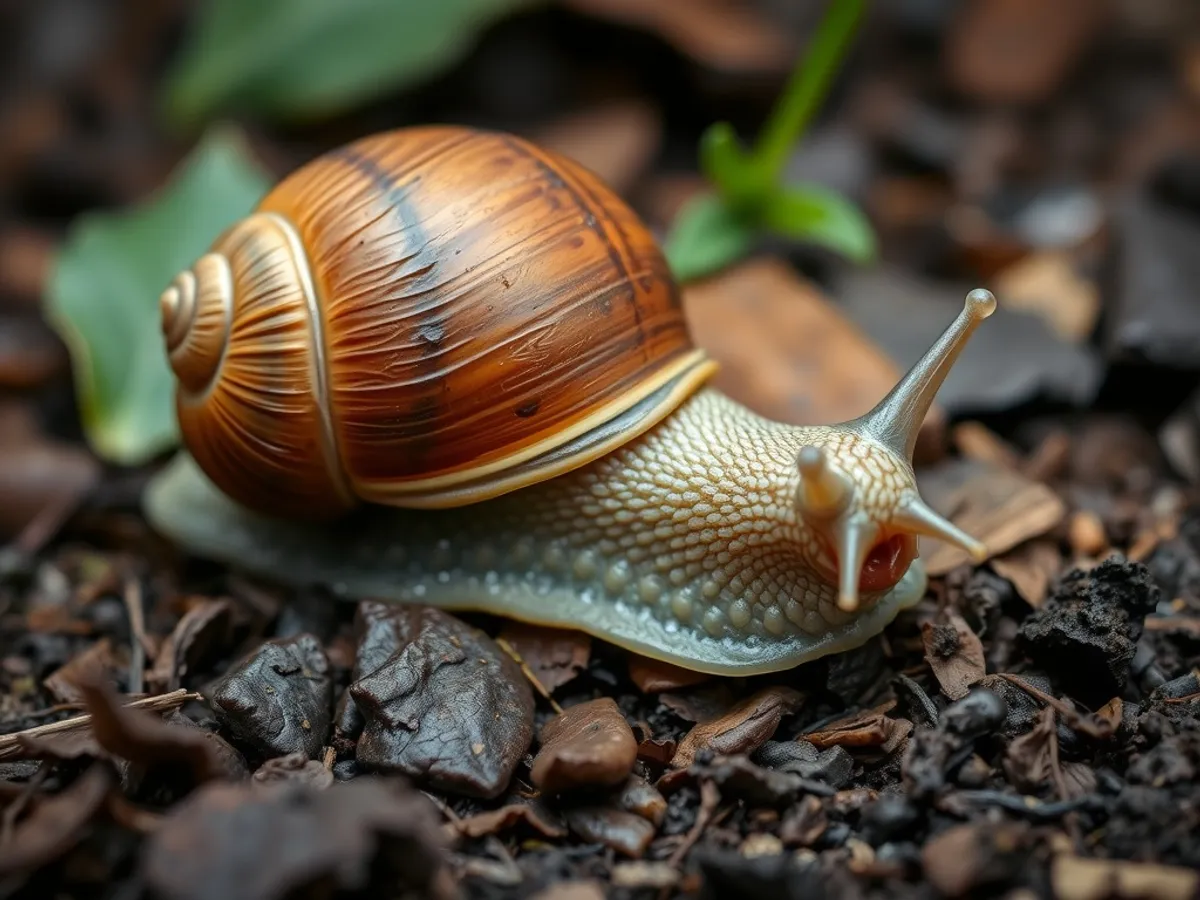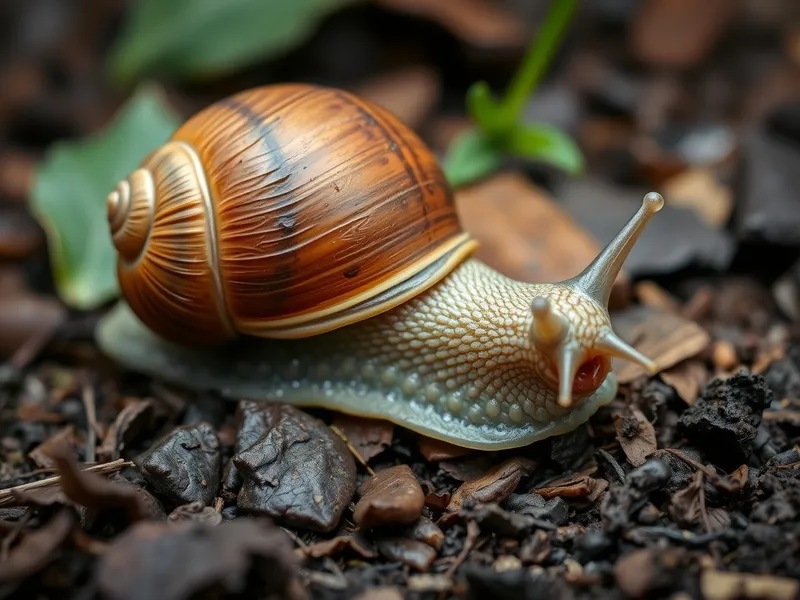
Garden Snail
Cornu aspersum

Meet the Garden Snail
The Garden Snail is a common terrestrial mollusk known for its coiled shell and slow movement. Native to the Mediterranean region, this snail has been introduced to many parts of the world, often found in gardens, parks, and woodlands. It is recognized by its brownish shell, which is usually patterned with yellow or cream bands. Garden Snails are mostly active during damp conditions and retreat into their shells to conserve moisture during dry periods. Their slow, gliding movement is aided by a muscular foot that secretes mucus, allowing them to travel smoothly over various surfaces.
Classification
Invertebrate
Habitat
Moist terrestrial environments such as gardens, forests, and hedgerows
Diet
Herbivore
Lifespan
2-5 years
Conservation
Least Concern
Weight
8-20 grams
📖Fascinating Facts
Hermaphroditic Nature
Garden Snails possess both male and female reproductive organs, allowing any two individuals to mate and exchange genetic material.
Diet Preferences
Their diet consists primarily of leaves, fruits, flowers, and bark, making them common garden pests in many regions.
Miniature Teeth
Garden Snails have a radula covered with thousands of tiny, chitinous teeth, enabling them to scrape food efficiently from plant surfaces.
📋Detailed Description
The Garden Snail (Cornu aspersum) is a medium-sized terrestrial pulmonate gastropod mollusk, typically measuring 25–40 mm in shell diameter and weighing up to 15 grams. Its shell is globular, dextral (right-coiling), and displays a variable coloration of brown with yellowish or cream bands and flecks, providing camouflage among leaf litter. The body is soft, moist, and grayish-brown, with a distinct muscular foot that produces copious mucus for locomotion and moisture retention. Two pairs of retractable tentacles are present: the upper, longer pair houses the eyes, while the lower pair is used for olfaction and tactile sensing. Cornu aspersum is primarily nocturnal, emerging during the night or after rainfall to forage, and exhibits estivation or hibernation in adverse conditions by sealing its shell aperture with a calcareous epiphragm. The species is hermaphroditic, possessing both male and female reproductive organs, and engages in elaborate courtship involving the exchange of 'love darts.' It feeds on a wide range of plant material, including leaves, stems, and decaying vegetation, and plays a significant ecological role in nutrient cycling. Garden Snails are solitary but may aggregate in favorable microhabitats, especially during dormancy. Their slow movement and reliance on mucus trails are key adaptations for terrestrial life, while their shell provides protection from predators and desiccation.
💡 Did you know?
Garden Snails have thousands of microscopic teeth arranged in rows on a ribbon-like structure called a radula, which they use to scrape food from surfaces.
🔬Research & Sources
🎭Behavior & Social Structure
Garden Snails are largely solitary but may be found in aggregations during periods of dormancy or in resource-rich environments. They are most active at night or during moist, overcast conditions to minimize water loss. Locomotion is achieved via rhythmic muscular contractions of the foot, aided by mucus secretion that reduces friction and prevents injury. Feeding is accomplished using a radula, a ribbon-like structure covered with thousands of microscopic teeth, allowing the snail to rasp and shred plant material. They exhibit selective feeding behavior, preferring tender leaves and decaying organic matter, but can consume a wide variety of vegetation, making them agricultural pests in some regions. Social interactions are limited, but chemical cues in mucus trails can influence aggregation and mate-finding. When threatened, Garden Snails retract fully into their shell, sealing the opening with an epiphragm to conserve moisture and deter predators. They exhibit homing behavior, often returning to the same resting spot after foraging.
👶Reproduction & Life Cycle
Cornu aspersum is a simultaneous hermaphrodite, meaning each individual possesses both male and female reproductive organs. Mating typically occurs in spring and autumn, often after rainfall, and involves a complex courtship ritual lasting several hours. During courtship, snails exchange 'love darts'—calcareous spikes that are shot into the partner's body, believed to increase reproductive success by influencing sperm storage. After copulation, both individuals can lay eggs, depositing clusters of 40–80 small, round, white eggs in moist soil or under debris. Incubation lasts 2–4 weeks depending on temperature and humidity. There is no parental care; juveniles hatch fully formed and begin independent life. Garden Snails can produce several clutches per year, with reproductive output influenced by environmental conditions.
🛡️Adaptations & Survival
Garden Snails possess several adaptations for terrestrial life, including a robust, calcified shell for protection against desiccation and predation. Their ability to produce a mucus epiphragm allows them to survive periods of drought (estivation) and cold (hibernation). The radula enables efficient feeding on a variety of plant materials, while their chemosensory tentacles aid in locating food and mates. The hermaphroditic reproductive system increases the likelihood of successful mating encounters. Behavioral adaptations include nocturnal activity patterns and homing abilities, which reduce predation risk and optimize microhabitat use. Their slow metabolism allows survival during extended periods of inactivity.
📚Research Sources
🎨Cultural Significance
Garden Snails have been consumed as a delicacy in Mediterranean and European cuisines for centuries, particularly in France, Spain, and Italy. They appear in folklore and symbolism, often representing patience, perseverance, and the cyclical nature of life. In some cultures, snails are associated with fertility and renewal due to their reproductive capacity and emergence after rain. Their shells have been used in jewelry and decorative arts, and their slow movement has inspired metaphors in literature and art. In modern times, snail mucin is used in cosmetics for its purported skin benefits.
🔬Recent Research & Discoveries
Recent research has focused on the neurobiology of Cornu aspersum, particularly its learning and memory capabilities, which have made it a model organism in studies of simple nervous systems. Studies on their mucus have revealed complex glycoproteins with potential medical and cosmetic applications. Genetic analyses have clarified the species' phylogeography, revealing multiple introductions and hybridization events outside its native range. Ongoing research is examining the impacts of climate change on their phenology and distribution, as well as their role in soil nutrient cycling and as bioindicators of environmental health.
🎥Wildlife Videos

garden snail documentary about snails ft totally David Attenborough
J980

Slow down with Snails and Slugs | Relax With Nature | BBC Earth
Allow yourself to move at a snail's pace and relax with the movement of these slow-moving creatures. Subscribe: ...
BBC Earth

4K - A Small Journey Into The Slow World Of Snails - Relaxing Small Wildlife Documentary
Embark on a serene journey into the slow and fascinating world of snails with A Small Journey Into The Slow World Of Snails ...
Stay Curious

The Secret Life of Snails: Nature’s Slowest Adventurers | 4K
They may seem slow and simple, but snails live fascinating lives filled with survival secrets, unique adaptations, and unexpected ...
Savage & Serene

Spiral | WILDxRED
Banned from its Heaven, our tiny hero is determined to crawl its way back. Dive into the epic journey of a snail as it battles through ...
Nat Geo Animals

Discover the Fascinating World of Snails: Nature's Slow-Moving Marvels | Electric Snail
Snails are small creatures that we often overlook, but they have a fascinating world of their own. In this video, we will explore the ...
Devsig
🌍Habitat Information
The Garden Snail typically inhabits Moist terrestrial environments such as gardens, forests, and hedgerows environments. Garden Snails have adapted to their environments with specialized features and behaviors.
Primary Habitat:
Moist terrestrial environments such as gardens, forests, and hedgerows
More detailed habitat information will be available soon.
🛡️Conservation Status
The Garden Snail is currently classified as Least Concern. Conservation efforts are crucial for preserving this species for future generations.
Common Threats:
- 🏠Habitat loss and fragmentation
- 🌡️Climate change impacts
- 🎯Hunting and poaching
- 🏭Human-wildlife conflict
⚠️Threats & Conservation Challenges
Currently classified as Least Concern by the IUCN, Cornu aspersum faces few significant threats at the global level due to its adaptability and widespread distribution. However, local populations may be impacted by habitat loss, pesticide use, and urbanization. In some regions, they are considered invasive and can outcompete native snail species, disrupt local ecosystems, and cause agricultural damage. Climate change may alter their distribution and reproductive cycles, but their ability to estivate and hibernate provides resilience. Predators include birds, small mammals, beetles, and parasitic nematodes. Human collection for culinary purposes (escargot) is localized and not a major threat to overall populations.
🔬Scientific Classification
Scientific Name
Cornu aspersum
Classification Hierarchy
🔍 About Taxonomic Classification
Taxonomic classification is a hierarchical system used by scientists to classify and organize living organisms based on shared characteristics and evolutionary relationships.
The system moves from broad categories (Kingdom) to increasingly specific ones, with each animal's scientific name typically consisting of its Genus and species.
📝Community Notes
Share your observations and insights about the Garden Snail with our community of wildlife enthusiasts.
Join Our Community
Sign in to share your observations and connect with fellow wildlife enthusiasts.
Sign In to ContributeNo community notes yet
Be the first to share your observations about the Garden Snail!
Explore Garden Snail
Select a tab above to learn more about this amazing animal.
📸Photo Gallery
No photos available for this animal yet.
🌟Discover More Wildlife
Continue your journey of discovery with more fascinating animals from our database
